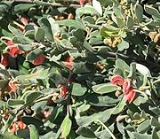
Grevillea arenaria
Encyclopedia
Grevillea arenaria is a shrub
which is endemic to the east of New South Wales
in Australia
. It has an erect to spreading habit and grows to between 1 and 3 metres in height. Its leaves are 1.5 to 7 cm long and 3 to 15 mm in width. The flowers, which occur in groups of 2 to 10, are pink, red or orange, with green or yellow at the base and green styles. These occur year round, with a major flourish in spring.
The species was first formally described by botanist Robert Brown
in Transactions of the Linnean Society of London in 1810.
There are currently two recognised subspecies
:
A former subspecies, known as G. arenaria subsp. montana (R.Br.) McGill., is currently treated as a species in its own right -
G. montana R.Br.
It occurs on sandy soils in open forests in the Great Dividing Range
, its southernmost extent in line with Narooma
and its northernmost extent in line with Sydney
.
Shrub
A shrub or bush is distinguished from a tree by its multiple stems and shorter height, usually under 5–6 m tall. A large number of plants may become either shrubs or trees, depending on the growing conditions they experience...
which is endemic to the east of New South Wales
New South Wales
New South Wales is a state of :Australia, located in the east of the country. It is bordered by Queensland, Victoria and South Australia to the north, south and west respectively. To the east, the state is bordered by the Tasman Sea, which forms part of the Pacific Ocean. New South Wales...
in Australia
Australia
Australia , officially the Commonwealth of Australia, is a country in the Southern Hemisphere comprising the mainland of the Australian continent, the island of Tasmania, and numerous smaller islands in the Indian and Pacific Oceans. It is the world's sixth-largest country by total area...
. It has an erect to spreading habit and grows to between 1 and 3 metres in height. Its leaves are 1.5 to 7 cm long and 3 to 15 mm in width. The flowers, which occur in groups of 2 to 10, are pink, red or orange, with green or yellow at the base and green styles. These occur year round, with a major flourish in spring.
The species was first formally described by botanist Robert Brown
Robert Brown (botanist)
Robert Brown was a Scottish botanist and palaeobotanist who made important contributions to botany largely through his pioneering use of the microscope...
in Transactions of the Linnean Society of London in 1810.
There are currently two recognised subspecies
Subspecies
Subspecies in biological classification, is either a taxonomic rank subordinate to species, ora taxonomic unit in that rank . A subspecies cannot be recognized in isolation: a species will either be recognized as having no subspecies at all or two or more, never just one...
:
- G. arenaria R.Br. subsp. arenaria
- G. arenaria subsp. canescens (R.Br.) Olde & Marriott
A former subspecies, known as G. arenaria subsp. montana (R.Br.) McGill., is currently treated as a species in its own right -
G. montana R.Br.
It occurs on sandy soils in open forests in the Great Dividing Range
Great Dividing Range
The Great Dividing Range, or the Eastern Highlands, is Australia's most substantial mountain range and the third longest in the world. The range stretches more than 3,500 km from Dauan Island off the northeastern tip of Queensland, running the entire length of the eastern coastline through...
, its southernmost extent in line with Narooma
Narooma, New South Wales
Narooma is a town in the Australian state of New South Wales on the far south coast. The town is on the Princes Highway. The name is said to be derived from the Aboriginal word meaning ‘clear blue waters’. At the 2006 census, Narooma had a population of 3,100 people.Montague Island, a National...
and its northernmost extent in line with Sydney
Sydney
Sydney is the most populous city in Australia and the state capital of New South Wales. Sydney is located on Australia's south-east coast of the Tasman Sea. As of June 2010, the greater metropolitan area had an approximate population of 4.6 million people...
.

